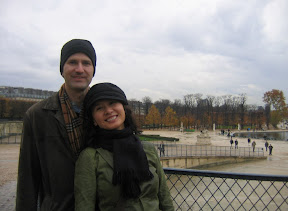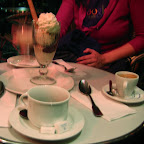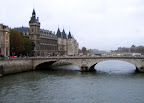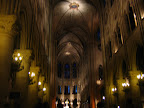星期六, 十二月 16, 2006
 Paris.Girona.Barcelona (3) Paris.Girona.Barcelona (3)
Day 3: Top of Notre Dame.Ste.Chappelle.LouvreWe started the next morning by scaling the tower of Notre Dame de Paris, a favorite tourist pastime. Imagining ourselves as Esmeralda following Quasimodo, we climbed up the narrow spiralling stairs. At the top we were treated to a lovely view of the city, and numerous photogenic chimeras -- our pamphlets informed us that chimeras are not gargoyles, though both were made-up monsters composed of different creatures: gargoyles are used as drain pipes, while chimeras do not have a practical purpose. Everyone went wild taking photos. Matthew was espeically fascinated with the creatures' backs: weathered from centuries of the Paris wind and rain, the mossy and eroded backs seemed to tell a tale of time. 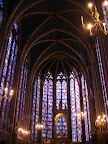 On our way to the Louvre, we dropped by the little chapel of Ste. Chappelle, a study of contrast compared to the vast, solid, and fortress-like Notre Dame. The chapel was almost made entirely of stained glass, supported by thin columns that are barely visible. The architects intention was to have a chapel of colour and light that floated in the air but this was achieved by cleverly hiding the solid, gothic structure. It was built to house an important Christian relic -- the crown of thorns, which the devout king Louis IX spent an exorbitant sum to import (about 3 times the money it took to build the chapel itself). In many respects I found Paris to be more technologically advanced than the U.S.. One good example is the use of this handy little credit card processing machine, found in every restaurant, which the waiter brings to the table and settles the bills efficiently -- very useful when multiple credit cards are on the table. Another example, fresh in my mind that morning, was the stove/oven we had in our apartment -- though we spent quite some time to figure out how it works, with combined efforts at deciphering the French operating manual as well as pressing the buttons at random, once you figure out how it works, it's smart and effective. But in some aspects the French system of doing things reminds me of China, somewhat bureaucratic. For example, in stores, you pick the items you want to buy and then collect a piece of paper which you take to pay at the cashier, then come back to retrieve the item... but I'm getting off topic, this is a more organizational issue than a technological one. Anyway, wherever tickets are sold in Paris, chances are that you need to buy it from a human, and it's not for the lack of machines, but somehow the machines just don't seem to do the work as well as the humans: here at the Louvre, there was a big line for the entrance tickets, and hidden behind it was a ticket-selling machine, with about 2 people lined up behind it. The machine was so positioned that you only see it when you progress to the middle of the line-up, so at first we thought that it must be the reason that there were so few people lining up there. Matthew lined up after the two people but I remained in the original line just in case the machine doesn't work or something. It turned out to be a wise move: though there were about 20 people in front of me, my line was moving so much faster than Matthew's that I actually got my turn faster than him. Somehow when it comes to selling tickets (or checking in at the airport, as we found out later), the French machines are just no match for dealing with a person.  We were warned that to visit the Louvre one must have a game plan, since it was simply too big. So we quickly identified the galleries that we really wanted to visit and devised a tour route. I had had misgivings about visiting museums -- I often find them stuffy and oppressive, seeing all the treasure of the past confined to a room, often behind glass. Though I knew that the Louvre had to be one of the best (if not THE best) museums in the world, I was not convinced that I'd actually like it. I was pleasantly surprised: the spacious and airy halls, with light streaming from the many tall windows, were not at all stuffy, even with hordes of tourists the place did not seem too crowded -- there was a crowd in front of the Mona Lisa all right, but not as bad as I expected. Most of the artworks were not behind glass, but arranged with dignity and room to breath. Each of the galleries is decorated in a distinctive style, and each wall of art here could command a special exhibition elsewhere in the world. Our favourites galleries are the Italian Renaissance rooms and the large French paintings. It is thrilling just to be in the presence of some of these paintings, to gaze at the same canvas that the masters worked on. Some paintings look a lot more exciting to me in person than from print or the web (in the room where the Mona Lisa resides, I became a convert of Titian's), whereas others less so. It was also quite startling to find the true size of some of the famous paintings -- the tiny size of a Vermeer, the huge ones by Delacroix... 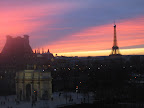 The museum was HUGE, and there was a lot of walking involved. Happily, we covered our planned route just in time. As night descended on the gardens outside, we had a lovely view of the sunset through the large windows. We were exhausted and ready to leave, but we will come back again, sometime. Of all the museums I've been to, the Louvre is undoubtedly the best. It made me want to go back to Italy, to revisit all that Renaissance art that I just skimmed through the last time. That evening we dined at Aux Tonneaux des Halles, a restaurant recommended by our guidebook which served typical French food. Rue Montorgueil had been a longtime location of Paris' food market district but since the relocation of the markets to the suburbs in the 1960s was now simply another street of cafes with some historic restaurants and an imposing local Gothic church. The waitress was by far the most friendly attendant at any restaurant in France that we met. When she ran out of English words, she used various parts of her body to illustrate the dishes on the menu: Andouille sausage -- she pointed at her stomache; calf's head -- she pointed at her head, then added significantly: "beef's children"... Matthew had his first Steak Tartar, and we enjoyed our first bottle of Beaujolais Nouveau. View all Day 2 photos.
posted by gz 1:21 下午
留言/

星期二, 十二月 12, 2006
 Paris.Girona.Barcelona (2) Paris.Girona.Barcelona (2)
Day 2: Montmartre.Cemetery.Place de la Concorde.Musée d'Orsay.Eiffel Tower The next morning I woke up at 4AM, jet-lagged and starving. After much tossing and turning to no avail, I eventually got up at 6. When Matthew and I descended into the courtyard, it was pitch black and dead quiet. I was wondering if nothing would be open, but out the gate on the street it was bustling -- it was still dark but traffic was brisk, people were walking about, and most importantly, numerous pattiserries were open for business, and locals had gathered in little cafes for their morning espresso. The rain had stopped. We wandered the old cobble stoned streets in the predawn darkness, marvelling at how well-insullated our apartment was: The Parisians really have a nice system for urban living. The just-baked croissants were heavenly, and the café au lait was soothing. By the time we came back to the apartment it was still early. We gathered up our travel companions and started a long day of exploration. 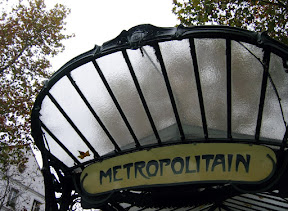 Art Nouveau Metro sign Besides having the world's best croissants and other pastries, Paris also has the metro -- the world's best subway system I've ever known, though my pool of reference isn't great, consistiing of the subway in Beijing, Toronto, San Fran, Shanghai, and Barcelona. A complicated labryinth of underground system with numerous intertwining lines, it is perhaps not the most efficient, with sections of duplicating lines, but certainly the most comprehensive and convenient: one is never far from a metro station, or two. This morning we hopped on the train and headed for the former artist enclave of Montmartre.  Set on a hill in the north part of the city, Montmartre had once seen more than its share of artists from the impressionists to beyond: Renoir, Toulouse-Lautrec, Degas, Modigliani, Matisse... Nowadays, it is decidedly more touristy than Bohemian, with streets lined with shops that peddle tourist trinkets. We walked by an apartment where Vincent Van Gogh once dwelled, past the workshop of Picasso (a non-descript looking block where he supposedly invented Cubism), up the hill to the white-domed Sacre-Coere for a sweeping view of Paris below us. It had started to rain again, and the rain seemed to suit Paris -- a city of myriad shades of gray luminous in the soft rain, always a little melancholy, looking its most romantic. 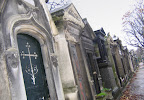 We strolled the nearby cemetery, a mini city of the dead, with its little chapel lined lanes. Here rest such illustrious figures as Berlioz, Degas, and Zola, among others. The cemetry is below street level, with a bridge straddling it, almost touching the roof of some of the ellaborate tombs. Real estate is always at a premium, even after death. Our next stop was the Place de la Concorde, with its sky-thrusting, gold-topped Obelisk of Luxor. The vastness of the square reminded me of one from my hometown. Marie Antoinette lost her head here, among others. Another sky-thrusting object from latter days rose from some distance behind the Obelisk: the Eiffel Tower. The Tuilerie Gardens lies on one side of the square. We could have taken the metro, but this was our first day and we were still thrilled at walking around Paris' cobble-stoned streets, so we walked along the river to the Musée d'Orsay. Originally a train station, the building is stunning as an art gallery. Somewhat to my surprise, among all the colorful Imressionist and Post Impressionist paintings, it was this Van Gogh that really commanded my attention (and Matthew's): so vibriant that it seemed to have a life of its own.  Leaving d'Orsay we walked back to the right bank, passing the Louvre. It was getting dark, and the infamous pyramid in front of the Museum was lit. To me it provided a not-unpleasant contrast to the old buildings, and I actually liked it. After a much needed rest back in our apartment, we went out searching for food. At the super crowded Le Bistrot Beaubourg, near the Pompedou, we had a hearty meal of steak and lamb chops, pate and salad, all washed down with plenty of wine. We discovered the huge portion of French meals (definitely bigger than American meals, which made us wonder how the French stayed so skinny), the cheapness of the wine (it's so easy to become an alcoholic here), and the attitude of Parisian service industry. Our waitress wore a perpetually disdained look on her pretty (but long) face, and practically threw everything on the tables (from menus to plates). She was really efficient though, throwing the food (and drinks) and retrieving the plates on the tables with perfect timing. And her long face was indiscriminately doled out to all the customers, not just the hapless foreign tourists. The night was still young, and the food and wine fortified us. We took the metro to the Champs-?lysées, hoping to see the street lighted up for Christmas. But the lights were not on, except for the shops and the Eiffel Tower beaming from across the river, with a moving search light probing like the Eye of Sauron. We decided to pay the tower a closer visit and hopped on the metro again. This time we were dumbfounded at the sight that greeted us: the tower was now twinkling! The whole thing was enveloped in bright lights and twinkling like one cheezy Christmas tree. Fortunately someone realized how ridiculous the thing looked (or maybe they want to save electricity) and switched off the twinkling lights, and it went back to merely looking like Sauron's tower again. We settled ourselves into the cafe with the best view and enjoyed it along with some scrumptuous dessert. Thus concluded our first full day in Paris. View all photos from the first two days in Paris.
posted by gz 1:44 下午
留言/

星期日, 十二月 10, 2006
 Paris.Girona.Barcelona (1) Paris.Girona.Barcelona (1)
Day 1: Arrival 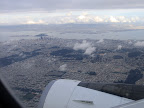 Leaving San Francisco Our first impression of Paris was a mixture of frustration and wonder (almost in equal parts). As our plane touched down on Charles de Gaules Airport in the light rain, there was excitement in the air, which soon turned into puzzlement, as the plane taxied on and on, farther and farther away from the terminal buildings. This was a really big airfield! About quite a few turns and several minutes later we finally stopped in the middle of some construction zone. Here we were packed into buses, and the puzzlement among the passengers started to turn into disgruntlement, as the bus leisurely took on a mysteriously circuitous route through the construction zone. Some sarcastically suggested that this must be for "security reasons", while a particularly unhappy customer ranted his disdain for the French system, predicting that if we ever reached the terminal we'd never get our bags, for the luggage-handlers would be on strike -- "someone is always on strike in France!" Of course, all the complainers were Americans; the French did not seem disturbed by our detours, only slightly puzzled at the impatience of the Americans. I was with the Americans: the airport construction zone in the rain, though no doubt a feat in engineering, was not one of the great sights we'd come all this way to see, but adding a complaining soundtrack to it was hardly helping. Just when the bus ride was starting to look endless to me (who was still cheerful when we got on the bus), we made one final turn and voilá, were deposited in front of the back door of our terminal. Upstairs, a huge line had formed in front of the immigration check, which was manned by...2 officers. But just as I was despairing at the prospect of an hour in line, we realized that these were two very efficient officers, who were practically wave people through, with hardly a sideway glance at their passports. Soon we found ourselves in the baggage claim area, excited again. After joking around for a few minutes about our detours, the luggage belts were still silent, and that familiar disgruntlement was starting to buzz again. We were wondering if that American who predicted a luggage handlers strike might turn out to be prescient, but eventually the bags started to pop out, to the relief of all the anxious Americans (and Canadians, needless to add) around. The next round of puzzlement was at the metro/train station, which was smartly connected to the terminal. Inexplicably (only to dumb foreigners of course) there were many machines selling all sorts of tickets and passes to everywhere, except to Paris -- these tickets had to be bought from humans, and hence a long line (well maybe not that long but still there's a line). These human-operated ticket booths were behind all the machines and hence not obvious to all the numb foreigners, therefore they erected an "Info" booth, powered by another human, who was becoming more and more irritated with answering the same question over and over again "Paris tickets are sold over there!" Do the French not believing in putting up signs? We felt a bit like a bunch of country bumpkins in town for the first time, marveling at every piece of curio -- at the entrance to the ticket booths there's coin machine , equipped with about 5 buttons, many a curious country bumpkins (including moi) went up to examine it, but being too timid to try out which button to push, all retreated coin-less. We hopped on the train, speeding through the gray suburbs with their huge concrete-block housing projects, and entered downtown underground. Our stop "Chatelet" was a big maze equipped with about 500 arrows pointing to different exits (and I thought the French don't use signs!). Sick of getting confused, we grabbed the closest exit -- a little elevator with just enough room for the 4 of us -- and were ejected onto the ground. And never had I been ejected into a more picturesque setting: We found ourselves on a bustling little street lined with shops and restaurants housed in old buildings, the gray tin roofs of the buildings and the cobble stoned street all shiny in the light rain, black-clad Parisians were walking about... Ah, we're in Paris! We had practically walked into a postcard of Paris. Our confusion and jet-lag forgotten, we marched toward our rental agent's office with smiles on our faces. Our rental agent, Damien, explained patiently to us how to use our stove -- being smart it needs some weight on it to operate. We were then handed the keys, all 3 of them. "These two works clock-wise, but this one the other way." On our instructions it says "The apartment is on the 5th French floor, the door is in the corridor". I thought this meant that there must be only one door, but Jean actually asked Damien what the apartment number was and on which side of the corridor. "There's only one door, no numbers."  5 French floors provides plenty of (too much!) exercise So we marched down the street, dragging our luggage -- my bag was not heavy, but VERY loud on the cobble stone, like a tank. It was raining a little harder now, but we were not concerned. We were in Paris! Our apartment was just across the street from Pompidou center, a bright mass of glass and steel and concrete in the middle of the monochrome of the old town. The apartment was in an old building, which though accessed from a main street, was hidden within a courtyard, with all the street noise blocked out. When after climbing the spiraled stairs n rounds, we lost count of the number of flights (since there're neither numbers nor signs -- turns out the well-signed subway is an exception after all), we landed on the top floor, and in the corridor, there were not just one, but all of five doors, challenging us to find the right one and open it. Having no brighter ideas, we tried them all with no success. One door did open but from inside with a angry Frenchman's face behind it. So we retreated to the floor below, figuring that we were on the wrong floor. However, there were just as many doors in this corridor and none of them yielded to our keys, except one, a tiny little room that bore no resemblance to the photos of the two-bedroom apartment we were promised. Exhausted, Jean and I planted ourselves on the sofa, sending the boys to find help. The room was tiny, but it had windows with pretty views of the courtyard below, and the shiny gray roofs surrounding it. This may not be our apartment, but since fate had temporarily deposited us here, we might as well make use of it by taking our first pictures of Paris.  Meanwhile the boys marched into the rental office and claimed that we had tried every single door on the top two floors but the keys didn't work. Damien bolted from his seat horrified: "They'd think you're burglars! They might call the police!" A man was send to rescue the situation. He arrived looking disdained at our ineptitude in opening locks, identified one of the five doors as the correct one and started to attacking it with the 3 keys. Soon he's no longer looking so superior, "it's difficult!" he conceded, but eventually figured out the trick after 10 minutes -- a complicated procedure which we tried to learn one by one, and happily at least two of us managed to open the door once. But the lock proved an obstacle to Matthew for a long time, and only with much practice did he eventually master the technique. The apartment behind the stubborn door was just as promised on the website, with spacious rooms, big windows, and a tiny bathroom. We were happy, if still puzzled at the logic of "there is only one door in the corridor." Based on my extremely limited knowledge of the French language, I think the way they express their numbers are revealing: for example, the word for the number "80" is actually 4x20, and to get any number between 80 and 100 you have to do multiplication and then addition! My conclusion is that 1) French must be good at math; 2) The French way of thinking is somewhat different... on a different dimension perhaps. Having settled down it was late afternoon, but we still walked out towards the river Seine, under a gray sky and light rain, everything was so atmospheric. At dusk, Notre Dame was dark and imposing, even with all the tourists, I still felt the echos of the middle ages in the candlelit, deep interior of the nave. We had arrived in Paris!
posted by gz 10:49 上午
留言/

| |
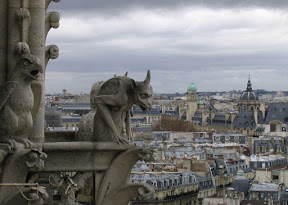




 Paris.Girona.Barcelona (3)
Paris.Girona.Barcelona (3) 




